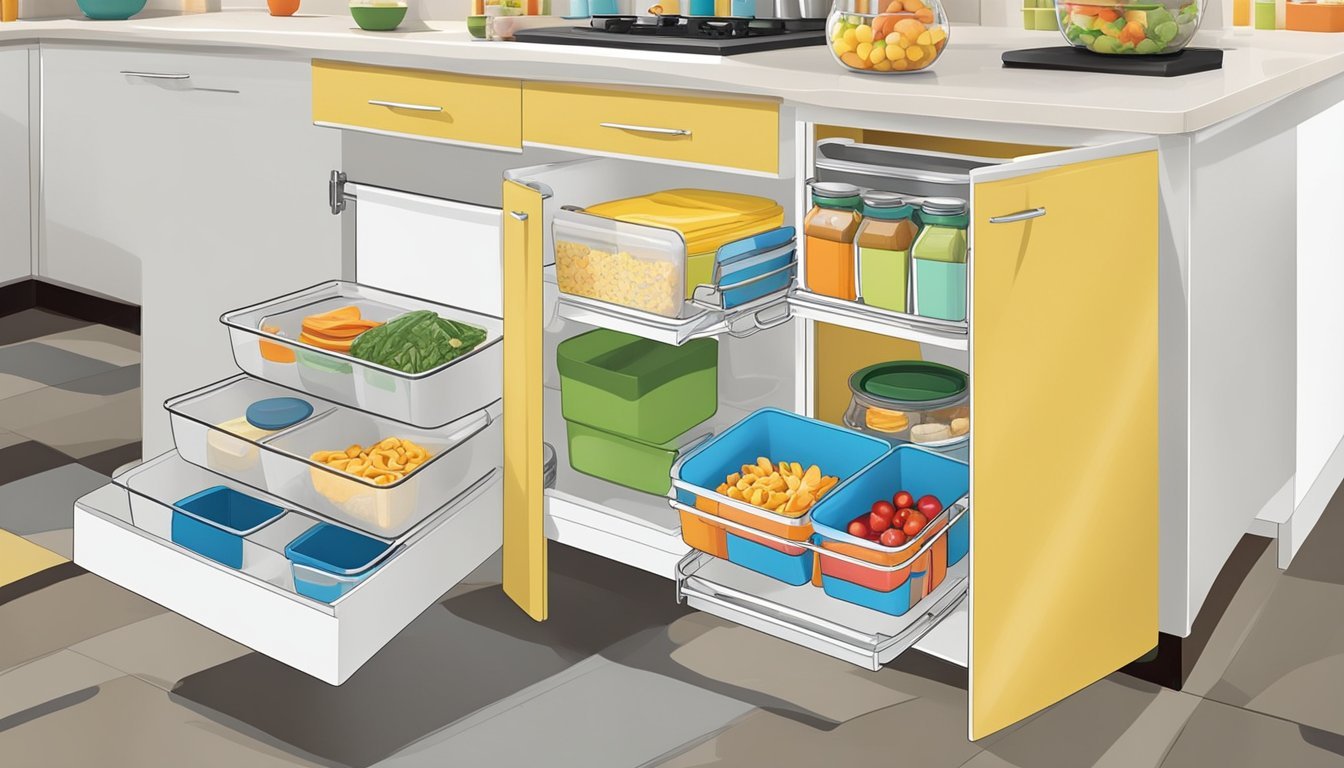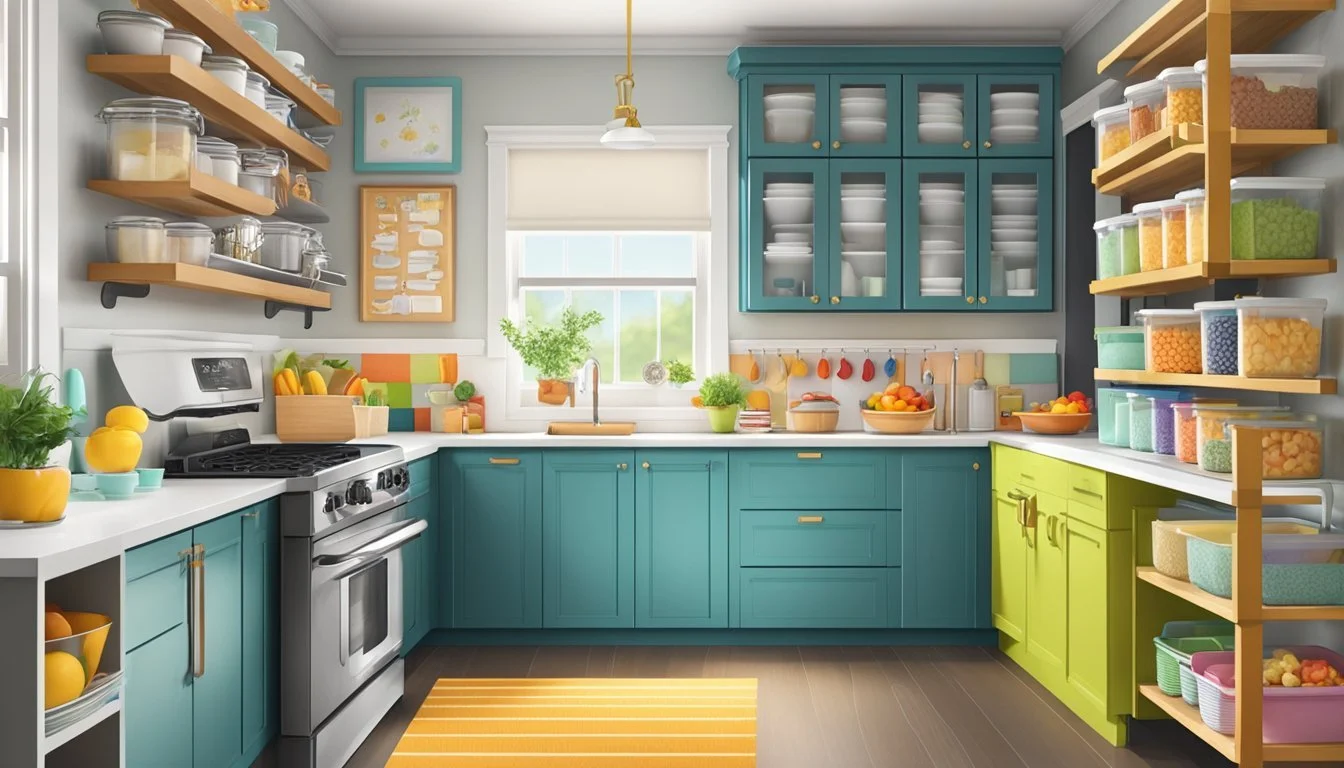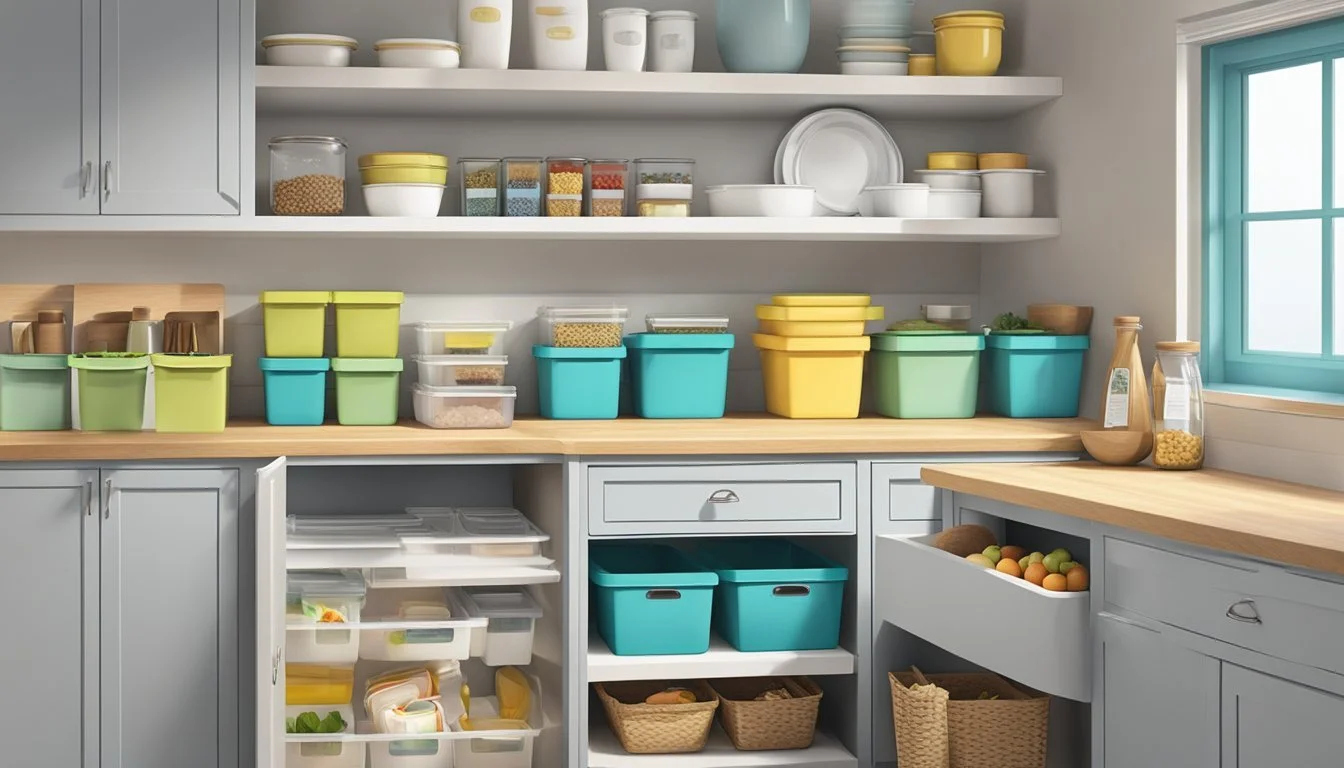How to Create a Kid-Friendly Kitchen Organization System
Essentials for a Safe & Tidy Space
A kitchen is often the heart of the home, where families gather to cook, eat, and share the day's experiences. It's a place not just for preparing meals but also for nurturing growth and learning. In households with children, the kitchen can be transformed into a kid-friendly zone that encourages independence, learning, and responsibility. Organizing a kitchen to cater to the needs of the younger members of the family involves strategic thinking and practical solutions that parents can implement to make daily routines smoother and safer.
Making a kitchen kid-friendly goes beyond safety locks and corner protectors. It encompasses the creation of dedicated spaces where children can access their own utensils, cups, plates, and healthy snacks (What wine goes well with snacks?). Lowering storage areas for these items to child-friendly heights empowers kids to help themselves and participate in meal preparation. This not only fosters their sense of autonomy but also creates an inclusive environment where even the youngest family members can contribute to kitchen activities.
Parents are tasked with the challenge of keeping the kitchen organized while ensuring it remains accessible to children. Implementing an organization system that involves clear labeling, the use of bins and drawers at reachable heights, and maintaining a clutter-free countertop can aid in this mission. Such a system not only optimizes the kitchen's functionality but also enhances safety by reducing the likelihood of accidents. With a well-considered organizational approach, parents can create a kitchen that serves as a foundation for children's self-reliance and interest in culinary activities.
Understanding Kid-Friendly Kitchens
Creating a kid-friendly kitchen involves thoughtful design that prioritizes safety and accessibility. The goal is to foster an environment where children can explore culinary interests safely and help in meal preparation with ease.
Defining a Kid-Friendly Kitchen
A kid-friendly kitchen is one that incorporates elements designed to ensure the well-being and engagement of children. This involves selecting features that minimize hazards and can include:
Countertops: Surfaces with rounded edges to prevent injury.
Materials: Durable, easy-to-clean surfaces that withstand spills and stains.
Storage: Lower cabinets and drawers that allow children to reach their utensils and safe kitchen tools.
The Importance of Safety and Accessibility
Safety is paramount in a kid-friendly kitchen. This encompasses a range of considerations:
Non-slip flooring: Choosing textures that reduce the risk of falls.
Childproofing: Incorporating locks on cabinets and drawers containing dangerous items.
Cooking zones: Using appliances like induction cooktops which remain cool to the touch in areas outside of active cooking pots.
Accessibility empowers children to participate in kitchen activities:
Accessible tools: Providing utensils and cookware suitable for small hands.
Lowered workspaces: Creating areas with lower countertops or adjustable height features for children’s use.
In making these considerations, parents and guardians can create a kitchen that not only ensures the safety of their children but also encourages their involvement and independence in cooking activities.
Essential Principles of Kitchen Organization
Organizing a kid-friendly kitchen is a precise blend of decluttering, maximizing functionality, and creating intuitive zones that cater to both adults and children. These principles work harmoniously to ensure a safe and accessible kitchen space.
Decluttering Basics
Decluttering is the first step in establishing an orderly kitchen. The goal is to remove items that are seldom used and may contribute to unnecessary crowding. This starts with sorting through kitchen items and eliminating duplicates, damaged goods, and outgrown children's utensils or dinnerware. Homes can often benefit from having a dedicated kid-friendly drawer or shelf at a lower height, ensuring children have access to their items without adult assistance.
Tip: Place kid-specific items in easy-to-reach locations and at an appropriate height.
Maximizing Functionality
A kitchen must be functional for all family members. This necessitates the strategic placement of tools and ingredients that are used regularly within arms' reach, and preferably at eye level for efficiency. When organizing, consider the flow of activities in the kitchen and the items needed for each. Kid-friendly tools and food items should be stored in a way that they can be easily seen and retrieved, fostering independence for children.
Tip: Use clear containers and labels for snacks to save time and prevent unnecessary searches.
Creating Zones
Zones transform a kitchen from a collection of items to a well-organized space with purpose. Each zone should represent a specific activity, such as food preparation, dining, or storage, with all the necessary items contained within that space. For instance, a designated snack zone in a pantry or a low cupboard allows children to help themselves without disrupting other areas of the kitchen.
Tip: Establish clear boundaries for each zone and maintain them consistently for ease of use.
By incorporating these key organizational principles, parents can create a kitchen that enhances their children's capacity to learn, participate, and gain autonomy in the heart of the home.
Strategies for Pantry Organization
Creating a kid-friendly pantry organization system involves implementing shelving solutions that cater to both accessibility and aesthetics, clear storage to easily identify contents, and a labeling system that benefits the entire family for maintaining order and clarity in the pantry.
Pantry Shelving Solutions
The foundation of a well-organized pantry is the shelving. Adjustable shelves are ideal, allowing customization as pantry needs change. Low shelves should be reserved for children’s snacks and items, positioning them at their eye level to foster independence. Higher shelves can be utilized for less frequently used items or pantry staples that require adult supervision.
Utilizing Clear Storage Bins
Clear bins are an excellent storage solution for maintaining an organized pantry. They allow children and parents to quickly identify snacks and ingredients without moving items around. Using a variety of sizes can accommodate different products, from large bags of chips to small boxes of raisins. Stackable clear bins maximize vertical space and keep the pantry looking neat.
Examples of Bin Usage:
Large bins for bulk cereal or chip bags
Medium bins for baking supplies and canned goods
Small bins for individual snack packs and spices
Labeling for Kids and Parents
Labels are a key component in maintaining the order within a pantry. They should be clear and simple to understand, with large print or icons that help even young children identify what goes where. It's beneficial for parents to label shelves or bins not just with the names of items, but also with categories or meal prep days to simplify the cooking process.
Labeling Ideas:
Breakfast items
Lunchbox snacks
Dinner ingredients
By using appropriate shelving, clear storage solutions, and effective labeling, a pantry can be transformed into a space that supports the entire family's needs, making meal preparation a less stressful task and encouraging children to be self-reliant in their food choices.
Safe Storage Options
Creating a kid-friendly kitchen requires careful planning to ensure that storage options are both accessible to children and safe for them to use. This involves placing tools and utensils within reach, while securing dangerous items out of harm's way.
Kid-Accessible Storage Locations
For a kitchen to be effectively organized for kids, storage should be at a level where they can reach without climbing. Lower cabinets and drawers are ideal locations for storing kid-friendly items such as plastic cups, plates, and utensils. It's beneficial to have designated spaces for these items, such as:
Bins and baskets in pantry or cabinet: Labelled by content for easy identification.
Open shelves at child's height: With daily-use items for independent access.
Within these storage areas, child-proof locks can safeguard items that are not suitable for children but are still stored within their reach.
Safe Storage Tools and Utensils
When selecting tools and utensils for a child-friendly kitchen, safety and durability should be the top considerations. Opt for items made from materials that are not easily breakable, such as:
Silicone or plastic measuring cups and spoons.
Stainless steel utensils with blunt edges.
Additionally, install organizers and dividers within drawers to keep utensils tidy and to prevent injury from sharp edges. Safe storage tools include:
Storage Solutions Description Utensil tray Separate compartments for different utensils. Magnetic strips For safely hanging metal utensils out of kids' reach. Secure knife blocks Store sharp knives in a block on a high shelf or locked drawer.
By incorporating these safe storage options, parents can empower their kids to participate in the kitchen while minimizing the risks involved.
Involving Kids in Kitchen Organization
Creating a kid-friendly kitchen organization system not only simplifies access to necessities but also offers an enriching environment for children to learn and participate in daily chores. By incorporating learning towers and teaching fundamental organizing skills, parents can foster a sense of creativity and build lasting memories with their children.
Learning Towers to Engage Children
A learning tower is a secure, elevated platform that allows children to reach countertops and sinks safely. They are specifically designed to foster a child's independence and participation in the kitchen.
Safety: It includes railings to prevent falling.
Accessibility: By enabling kids to be at the same level as adults, they can more easily engage in cooking activities.
Utilizing a learning tower, children can be closely involved in tasks such as washing fruits, mixing ingredients, and organizing items within their reach. This not only keeps them engaged but also builds their confidence and self-esteem as they contribute to family activities.
Teaching Organizing Skills
Teaching children how to organize their kitchen items empowers them and instills vital life skills.
Designate Kid-friendly Zones: Use lower shelves or drawers for storing children's kitchenware.
Clear Labelling: Labels aid in the organization and make it easier for children to remember where items belong.
Consistency: Keeping a consistent layout helps children memorize and maintain the kitchen's organization.
Instructing children on the organizing process allows them to understand the importance of keeping their environment tidy. It promotes consistency and responsibility while stimulating their creativity as they determine the best ways to arrange their belongings. As they master these skills, they're creating a foundation for an organized lifestyle that can extend beyond the kitchen.
Healthy Snack Solutions
Choosing healthy snacks and storing them properly are vital steps in creating a kid-friendly kitchen. These strategies help maintain the freshness of snacks while making them easy for kids to access, encouraging healthy eating habits and reducing food waste.
Accessible Healthy Snack Storage
For Accessible Healthy Snack Storage, parents should designate specific zones within the pantry, fridge, and freezer for kids’ snacks. Clear, labeled containers make it easy for children to find what they're looking for without assistance. Here’s a systematized approach to organizing snacks:
Pantry: Use low shelves for easy reach, stocking them with whole grain granola bars, nuts, and seeds.
Shelf Item Type 1 Whole Grains 2 Nuts and Seeds 3 Misc Healthy Snacks
Fridge: Reserve a drawer or a shelf for fresh items like string cheese, cut vegetable sticks, and fruit salads.
Section Item Type Drawer Fresh Vegetables & Fruits Shelf Dairy & Protein-based Snacks
Freezer: Allocate a drawer for frozen treats like frozen Greek yogurt bites or fruit popsicles.
Drawer Item Type 1 Frozen Healthy Treats
Preventing Food Waste
To Prevent Food Waste, visibility and portion control are key. Parents can:
Store perishable items in clear containers at eye level to ensure they are seen and eaten before expiring.
Freeze surplus fresh produce in individual servings, making it convenient for kids to enjoy later without the risk of spoilage.
Encourage kids to take only what they can eat by providing pre-portioned snacks.
Small steps like these not only foster an appreciation for food but also instill responsible consumption habits from an early age.
Do-It-Yourself Organization Hacks
Creating an organized kitchen that caters to kids involves both inventive DIY solutions and tested strategies from professional organizers. These approaches aim to simplify access, maximize space, and maintain visual appeal.
Creative DIY Storage
To begin with DIY storage solutions, families might consider repurposing common household items. Transparent plastic bins can replace original packaging for snacks, making it easy for kids to see and choose their foods. Labels play a pivotal role here—they eliminate guesswork and foster independence. Installing low-height shelves allows kids to reach their dishes and fosters a sense of responsibility. Additionally, magnetic strips on walls or inside cabinet doors can hold metal utensils safely out of reach from very young children, yet accessible to older ones.
Examples of DIY Kitchen Storage Solutions:
Transparent Bins: Group snacks and small items.
Drawer Dividers: Assign a place for utensils and cutlery.
Magnetic Strips: Store knives safely away from young children.
Hooks and Hanging Baskets: Utilize vertical space for items like aprons and sippy cups.
Insights from Professional Organizers
Professional organizers often emphasize the importance of a well-thought-out system tailored to a family's unique needs. They advise keeping the most frequently used items at eye level for kids. By doing so, kids can help in the kitchen with less supervision. Another tip is to avoid overcrowding; a clutter-free drawer or shelf simplifies the decision-making process for children. They also suggest using turntables in corners and deep cabinets to make every item easily reachable, and compartmentalizing drawers with simple dividers to keep similar items together.
Key Tips from Professional Organizers:
Place frequently used items within kids' reach.
Declutter spaces to simplify choices.
Use turntables in hard-to-reach cabinets.
Compartmentalize with drawer organizers.
Advanced Organizing Techniques
Creating a kid-friendly kitchen organization system calls for clever utilization of space and the incorporation of tools designed to streamline the function of a family-centered environment. Strategic placement and innovative products can significantly enhance efficiency and safety.
Efficient Use of Space
To maximize kitchen storage, focus on organizing items based on frequency of use and accessibility for children. A low pantry shelf or bottom cabinet can be dedicated to kid-friendly items such as plates, bowls, and cups. Utilizing stackable clear bins can keep snacks and small tools in plain sight and within easy reach, preventing overcrowding and minimizing the need for kids to climb or strain to access what they need.
Vertical Storage: Install racks on the backs of doors or use stackable shelves to increase vertical storage options.
Drawer Dividers: Employ adjustable dividers in drawers to neatly section off areas for kid-specific utensils and cutting boards.
Innovative Organizing Tools
The market offers a variety of organizing tools specifically designed to cater to the needs of a family kitchen. Magnetic knife strips, when placed out of reach of children, can safely store cutting boards and knives, while silicone utensil holders offer a flexible and easy-to-clean option for storing kitchen tools.
Labeling Systems: Consider investing in a labeling system for cabinets and drawers, which not only aids in identification but also teaches organization skills to children.
Pull-out Racks: Outfit cabinets with pull-out racks which can hold heavier items allowing children to safely help themselves without risking injury from pulling out items from overhead.
Creating a Calm Kitchen Atmosphere
Designing a calm, kid-friendly kitchen involves creating an environment that is both safe and serene. To achieve this, color choices play a crucial role. Selecting pale hues or soft pastel colors can set a tranquil tone for the space. Variable lighting is essential; incorporating dimmer switches provides control over the intensity to match different times of the day and various kitchen activities.
For organization, using clear bins and labels helps maintain a clutter-free environment while making it easy for children to find and put away items. Streamlined storage solutions ensure that every item has its designated place, reducing visual chaos. Open shelves with neatly arranged essentials not only look appealing but also keep things within easy reach for adults and not accessible for the little ones.
In the center of the kid-friendly kitchen stands a dedicated station specifically for children. Equipped with low countertops or a sturdy table, it provides a space where kids can engage in kitchen activities at their level. This dedicated area, clear of hazards and breakables, encourages autonomy while keeping the kitchen’s overall atmosphere calm and organized.
Textured flooring can minimize slips and falls, contributing to a safe environment that maintains the kitchen’s calm ambiance. Non-slip rugs or mats in strategic areas, such as in front of the sink or prep areas, can also add to safety while enhancing comfort and style.
To summarize, a kitchen that radiates calmness is well-organized, thoughtfully lit, and designed with safety in mind, all of which contributes to a soothing atmosphere that both children and adults can enjoy.





